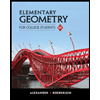By considering total area as the sum of the areas of all of its parts, we can determine the area of a figure such as the one shown to the right. Find the total area of the figure to the right. 9 (a parallelogram and a triangle) 16 A = (Simplify your answer.)
By considering total area as the sum of the areas of all of its parts, we can determine the area of a figure such as the one shown to the right. Find the total area of the figure to the right. 9 (a parallelogram and a triangle) 16 A = (Simplify your answer.)
Elementary Geometry For College Students, 7e
7th Edition
ISBN:9781337614085
Author:Alexander, Daniel C.; Koeberlein, Geralyn M.
Publisher:Alexander, Daniel C.; Koeberlein, Geralyn M.
ChapterP: Preliminary Concepts
SectionP.CT: Test
Problem 1CT
Related questions
Question
100%
Find the total area of the figure
![**Instruction:**
To find the total area of the figure, which consists of a parallelogram and a triangle, we first determine the area of each individual part.
- **Parallelogram**: The base is labeled as 9 units, and the height is given as 3 units. The area of a parallelogram is calculated by multiplying the base by the height.
\[
\text{Area of parallelogram} = \text{base} \times \text{height} = 9 \times 3 = 27 \text{ square units}
\]
- **Triangle**: The base of the triangle is also 9 units (same as the parallelogram), but the height is labeled as 6 units. The area of a triangle is calculated using the formula:
\[
\text{Area of triangle} = \frac{1}{2} \times \text{base} \times \text{height} = \frac{1}{2} \times 9 \times 6 = 27 \text{ square units}
\]
**Total Area**:
To find the total area, sum the areas of the parallelogram and the triangle:
\[
\text{Total Area} = \text{Area of parallelogram} + \text{Area of triangle} = 27 + 27 = 54 \text{ square units}
\]
**Graph Explanation:**
The diagram represents a figure composed of a parallelogram and a triangle. Both shapes share the base of 9 units. The triangle extends beyond the parallelogram’s top side, with distinct heights (3 units for the parallelogram and 6 units for the triangle) marked by dashed lines.](/v2/_next/image?url=https%3A%2F%2Fcontent.bartleby.com%2Fqna-images%2Fquestion%2F977ac1a7-2a1a-49aa-9358-74127afd8bcd%2F4040042a-f7af-4464-940d-8a873cc84415%2Fd6wp11j_processed.jpeg&w=3840&q=75)
Transcribed Image Text:**Instruction:**
To find the total area of the figure, which consists of a parallelogram and a triangle, we first determine the area of each individual part.
- **Parallelogram**: The base is labeled as 9 units, and the height is given as 3 units. The area of a parallelogram is calculated by multiplying the base by the height.
\[
\text{Area of parallelogram} = \text{base} \times \text{height} = 9 \times 3 = 27 \text{ square units}
\]
- **Triangle**: The base of the triangle is also 9 units (same as the parallelogram), but the height is labeled as 6 units. The area of a triangle is calculated using the formula:
\[
\text{Area of triangle} = \frac{1}{2} \times \text{base} \times \text{height} = \frac{1}{2} \times 9 \times 6 = 27 \text{ square units}
\]
**Total Area**:
To find the total area, sum the areas of the parallelogram and the triangle:
\[
\text{Total Area} = \text{Area of parallelogram} + \text{Area of triangle} = 27 + 27 = 54 \text{ square units}
\]
**Graph Explanation:**
The diagram represents a figure composed of a parallelogram and a triangle. Both shapes share the base of 9 units. The triangle extends beyond the parallelogram’s top side, with distinct heights (3 units for the parallelogram and 6 units for the triangle) marked by dashed lines.
Expert Solution
This question has been solved!
Explore an expertly crafted, step-by-step solution for a thorough understanding of key concepts.
This is a popular solution!
Trending now
This is a popular solution!
Step by step
Solved in 2 steps with 2 images

Knowledge Booster
Learn more about
Need a deep-dive on the concept behind this application? Look no further. Learn more about this topic, geometry and related others by exploring similar questions and additional content below.Recommended textbooks for you

Elementary Geometry For College Students, 7e
Geometry
ISBN:
9781337614085
Author:
Alexander, Daniel C.; Koeberlein, Geralyn M.
Publisher:
Cengage,

Elementary Geometry for College Students
Geometry
ISBN:
9781285195698
Author:
Daniel C. Alexander, Geralyn M. Koeberlein
Publisher:
Cengage Learning

Elementary Geometry For College Students, 7e
Geometry
ISBN:
9781337614085
Author:
Alexander, Daniel C.; Koeberlein, Geralyn M.
Publisher:
Cengage,

Elementary Geometry for College Students
Geometry
ISBN:
9781285195698
Author:
Daniel C. Alexander, Geralyn M. Koeberlein
Publisher:
Cengage Learning